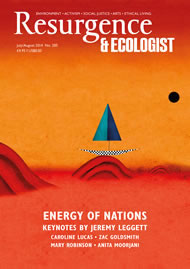Cows Save the Planet addresses three of the most serious problems facing humanity today: desertification, global warming, and the growing epidemic of obesity. The unifying factor in all three crises is soil.
The author, Judith D. Schwartz, interviews farmers, soil scientists and hydrologists to uncover the mystery of how to restore the health of our soils and thereby heal humanity and the planet. These visionaries are developing an agriculture that replenishes aquifers, restores biodiversity, and reverses desertification and global warming.
Conventional wisdom says that soil is formed by weathering rocks, a process that takes thousands of years to form an inch of soil. But with holistic management, farmers are able to create up to an inch of topsoil a year.
The story begins with Rhodesian park ranger Allan Savory, who discovered that the trampling of bunched herds of herbivores is essential to pasture health in dry areas. It pushes dead grass into the ground, where it can decay and return nutrients to the soil instead of locking them up and casting shade that inhibits new growth. Trampling also breaks up the soil surface, allowing rain to penetrate and seeds to germinate.
When livestock are able to spread out, they eat only their favourite foods, allowing weeds to flourish. When they are bunched together, they eat or trample everything in an area, and weeds lose their competitive advantage.
Twelve million hectares of farmland are lost to desertification each year. In North America 74% of dry land is moderately or severely desertified. Climatologists are very concerned that global warming will increase desertification, but desertification also increases global warming, in a vicious cycle. In the absence of water to keep it cool or plants to shade it, soil becomes very hot with the sun shining on it; most microbes die and the remainder rapidly oxidise the carbon in the soil, releasing it into the atmosphere.
The world’s farmland has lost 50–80% of its carbon and this has contributed twice as much as fossil-fuel burning to the increase in atmospheric CO2. Fortunately this loss of carbon is reversible. On well-managed organic farms, each time livestock eat grass the roots die off and decay into humus, a form of soil carbon that holds water and nutrients and boosts fertility. When livestock move on, the grass grows back above and below ground, and the cycle repeats.
Up to 40% of the carbon captured by plants can be sequestered in the soil, but this doesn’t happen on conventional farms. Most grasses and pasture plants have beneficial fungi called mycorrhizae attached to their roots, and these vastly extend the plant’s reach and its ability to absorb water and nutrients. Mycorrhizae are damaged by tilling and fungicides and inhibited by synthetic fertilisers. And pesticides kill earthworms, essential for recycling dead plant material, and termites, which perform the same function in drier areas.
Tree planting is a way of sequestering carbon and reducing climate change, and in many parts of the world trees play a very important role in stabilising climate, by pumping water into the atmosphere, ensuring plentiful rain. Large-scale deforestation is frequently followed by drought, as in the Amazon today. However, large areas of the world don’t receive enough rain to support trees. Trees also don’t pump carbon into the soil in the same way as periodically grazed grassland does.
After examining desertification and global warming, Schwartz turns to human health. Although there are 13 minerals essential to plants, and more to humans, conventional agriculture neglects most of them, focusing on just the three elements required in the largest amounts. As a result, levels of zinc, calcium, manganese, iron and copper in our food today are less than half what they were a century ago. The world’s most popular herbicide, glyphosate, compounds the problem. Glyphosate kills plants mainly by binding minerals so that they can’t be used. When glyphosate is used in fields, the resulting plants are severely mineral deficient, as are consequently the people and animals who eat them. This may be a significant part of the reason why we have an epidemic of obesity and chronic diseases today.
Organic farming, in contrast, focuses on supplying soils with all the nutrients needed to produce strong, healthy plants. While there have been relatively few studies on humans, numerous studies on animals have found significant improvements in health, including reduced fat, when they are fed an organic diet.
Written by a journalist, the book is very easy to read. There’s no discussion of feeding livestock a diet high in tannins, which inhibit the bacteria that convert food into methane, reducing methane emissions and boosting productivity, but otherwise the book is an excellent overview and reveals several crucial ideas that are almost entirely ignored in mainstream discussion of climate and human health.







